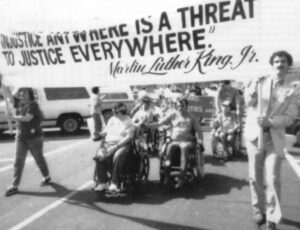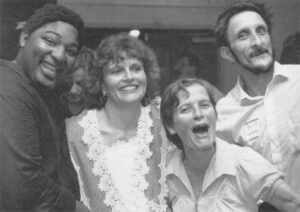Photos and text by Joseph P. Shapiro.
Jeff Gunderson’s voice is choked with worry. He is about to reenter the place he calls “the concentration camp.” It is a nursing home, one of two where Gunderson, who has cerebral palsy, was sent from the time he was 18 until he turned 27.
“I always said if I had to come back here, I’d rather be six feet under,” Gunderson says nervously as his attendant tugs him from the car parked outside the nursing home and lifts him into his wheelchair. Nine years have passed since he had lived here. He has returned to this brown-brick building of his nightmares because he wants to introduce a reporter to his former roommate, another man with cerebral palsy who, he says, is anxious to get out.
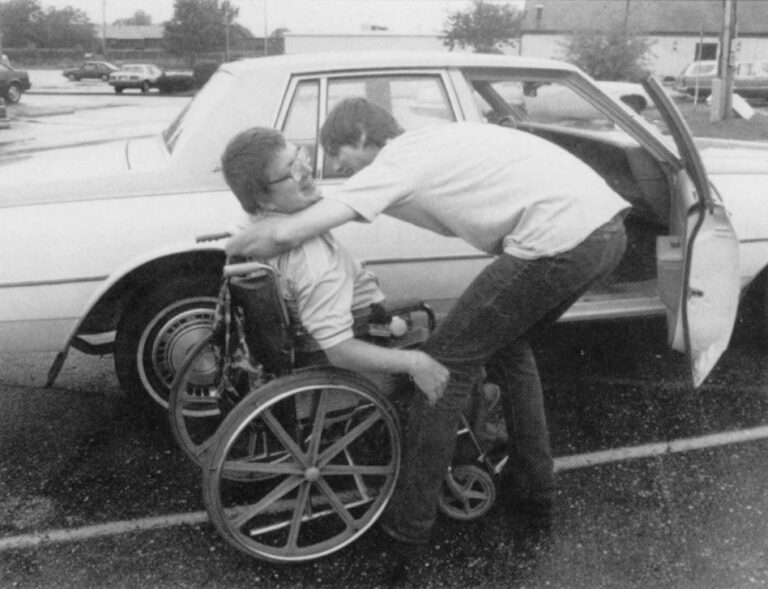
Gunderson wound up at this Beloit, Wisconsin nursing home-where he says he was abused and forgotten after his mother and father divorced. His mother could not lift her large son out of bed and care for him. Hiring an attendant to come into the Gunderson home was not covered by private or public insurance and was prohibitively expensive for the woman who worked on a canning factory assembly line. But Medicaid does pay for all of the costs of a nursing home. So Gunderson’s mother-as many other parents of severely disabled sons and daughters-had little choice: She put her teenage son in a nursing home.
Now back at the nursing home, Gunderson sees an ambulance that has pulled to the front door. It is a bad omen, he thinks, making him remember how death was a constant here. The two nursing homes where Gunderson lived were set up to care for the elderly, not for the young. Gunderson was required to follow the same regimen as the generally sickly, elderly people around him. This made it easier for the nursing home staff. He went to bed at 7 p.m., the same time as his first roommate, a man in his 80s. His food was bland, unseasoned, often a form of gruel made for older residents who could not eat solid food. Gunderson admits he rebelled: “I’d have fits.”
At both nursing homes, Gunderson says, the staff tried to break him. Sometimes aides tied him to his bed. They would drag him into cold showers as punishment. To make him use the bathroom, on a schedule convenient for the nurses, they would put ice cubes down his pants. It was a form of torture for Gunderson, since the cold set off his spastic muscles. On several occasions, Gunderson says he was given a suppository before sleep and, since he could not move by himself, he would spend the night lying in his own feces. (Officials at both homes say they are unaware of the incidents and that such practices would have been against their policies.) Until his last years in this second home, days were spent in bed watching soap operas. “Many times I wanted to kill myself,” he says. “I planned it, too.”
Inside the nursing home, the antiseptic hospital smell is strong and the hallway lights are bright. Gunderson is panicky. He greets staffers with a cheery, “Remember me?” But he ignores the severely disabled young people, who now live on a separate wing, some of whom are excited to see him. Loud music, from a radio, comes from one darkened room where a man lies curled up in a hospital bed. Gunderson, wheeled down the hall by his attendant, cannot find George, his former roommate. George is gone, he announces, perhaps he no longer lives here.
Quickly outside again, Gunderson relaxes at a nearby restaurant with a hamburger. An elderly man enters, wearing a white cap, white pants and an emerald green sweater. It is George’s father. He comes to the nursing home everyday to feed his son. George, it turns out, had been there and Gunderson had spotted him. He was the man with the radio. But Gunderson had not been able to face him. His reasons are vague. “George probably would have thought I would stay there with him,” he explains.

Later, on the telephone, George’s father, a friendly retired restaurant owner, explains that his son “got hurt at birth.” George’s mother takes the receiver. Would they like to see their son out of the nursing home, like Gunderson, in his own apartment with an attendant? It is not possible, says the mother. Her son is “absolutely, completely helpless, he has no communication, he needs to be dressed.” The staff at the nursing home is very caring, she says. Only she and a few of the aides know George well enough to understand him when he speaks. One nurse has recently devised a board with pictures. George can point to a picture of “water” when he wants to drink or “radio” when he wants his music. A therapist has begun working with him, softly throwing a ball to George and giving him colored blocks to stack. The mother notes, “They have a program with the children.” George is 49.
Gunderson, now 36, lives in a subsidized, two-bedroom apartment. He shares it with his attendant, Shaun Boyd, who helps him dress, bathe, toilet, cook, eat, do housework and get around town. Gunderson works three days a week at a sheltered workshop where he is paid a piece rate to help pack boxes of chili that go to grocery stores. He runs up his phone bill, talking long hours to friends. Bowling trophies-he is in two leagues are scattered around his large living room. His neighbor comes over to watch football. Boyd has become his closest friend. The two eat out together, take rides in Boyd’s secondhand car, or stay up late watching rented movies. “I can go out and do things for myself now,” Gunderson says. “I used to be a shy person because of all those years living in a nursing home.”
Younger people like Gunderson, between 18 and 64 years old, make up 10 percent of the population of U.S. nursing homes. There they lose “the basic rights that the rest of us take for granted, like choosing where they live, who they live with, what they eat, when to eat, who their friends are or if they are going to have sex,” argues Tom Hlavacek of United Cerebral Palsy of Southeastern Wisconsin. “If it happened to us we would scream holy hell and go to the highest court in the land. We do it to people with disabilities all the time and we feel justified by the fact that they have a disability.”
Most disabled people in nursing homes have developmental disabilities, such as mental retardation and cerebral palsy. Others have muscular dystrophy and similar illnesses. But a new class of residents includes young people with spinal cord and head injuries, who likely would have died from their accidents before medical technology of the last two decades. There have been several recent cases, like that of 34-year-old Georgia quadriplegic Larry McAfee, of young people going to court for the “right to die” when they face lifetimes in nursing homes.
In the 1970s, states started closing large institutions after lawsuits and newspaper exposes attacked the hellish conditions at many of these facilities. Often residents were removed from one institution only to be dumped into another-a nursing home-that was equally regimented, inappropriate and sometimes abusive. The number of people with developmental disabilities in state institutions dropped from 195,000 in 1971 to 88,000 today. But the total of developmentally disabled younger people from 18 to 64 years old-in nursing homes grew by a third in that same period, according to K. Charlie Lakin of the University of Minnesota.
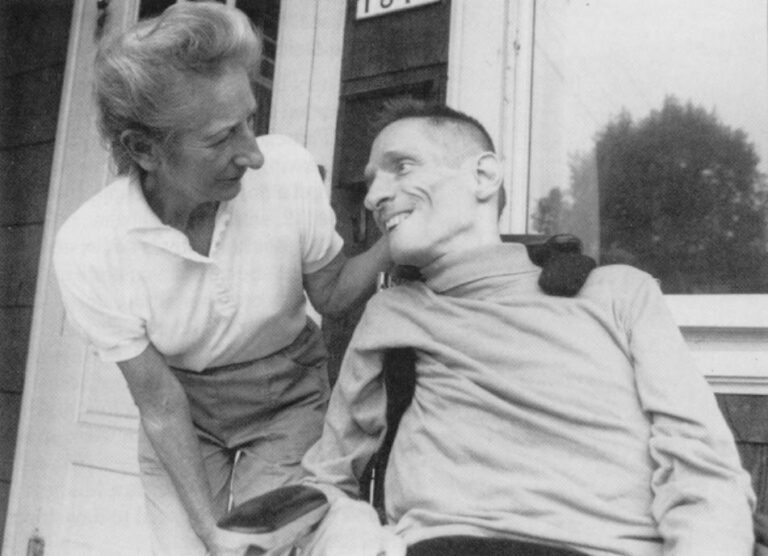
Some 148,000 people under 64, of various disabilities, lived in nursing homes in 1987, according to the U.S. Department of Health and Human Services. Some are there because they or their parents prefer it. But most want to live on their own, says Nancy Hansen-Bennett of United Cerebral Palsy of South Central Wisconsin, the group that helped Gunderson move into his own apartment. Even the most severely disabled person can manage outside of a nursing home with attendant care and other support, she says. Power wheelchairs, computers with voice synthesizers and innovative group homes and work programs allow unexpected independence. And living in the community is always less expensive, Hansen-Bennett says, since nursing homes employ costly nurses and doctors, which are not needed by someone who has a disability but is in good health.
Gunderson is one of the first users, and biggest success stories, of Wisconsin’s Community Options Program. It gets disabled and elderly people out of nursing homes and into their own apartments and group homes. Some 18,000 disabled people are served by Wisconsin’s various community programs, but there are another 5,800 on waiting lists, who either live in institutions or with family members.
Visits to Gunderson and others in Wisconsin-where there are 4,600 people between 18 and 64 in nursing homes according to the Wisconsin Council on Developmental Disabilities-make it clear that who stays in a nursing home and who gets out is often quirky business. It may be a matter of not having a friend or family member to be a strong advocate with the bureaucracy, as in the case of James Lee, an articulate 37-yearold man with cerebral palsy who wakes up at dawn but often waits until noon for the nurses at his understaffed skilled nursing facility to get him out of bed.
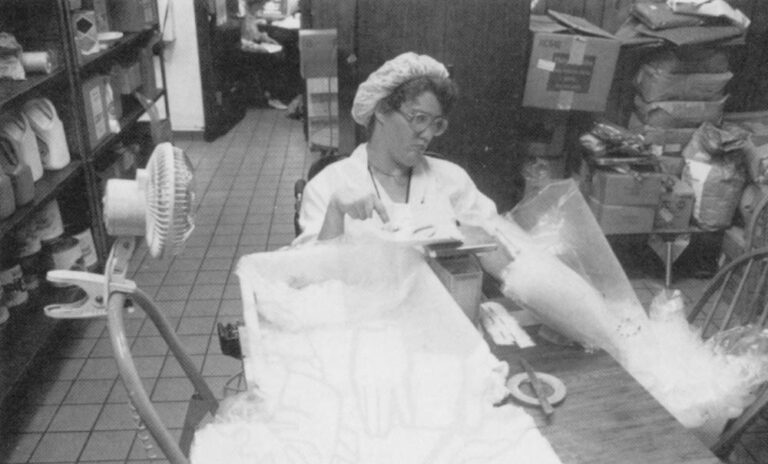
Or it may be a matter of running into cold-hearted bureaucratic rules, as in the case of Pamela Erickson who has no hope of leaving her nursing home until she can get a proper wheelchair. Erickson, 42, with cerebral palsy, is lively and verbal. But her body is so twisted by scoliosis that she needs a customized wheelchair to keep her sitting upright. The special chair would cost about $4,000. Wisconsin Medicaid, however, will not reimburse for a nursing home resident’s customized wheelchair, unless it can be proven to help them work or live on their own. No one can give Erickson money for the chair since, as a Medicaid recipient, she is not allowed to have more than $2,000.
So Erickson has spent 15 of the last 16 years in the home lying on a padded, wooden cart with large wheels. It is her prison. Recently, at her Milwaukee nursing home, Erickson’s cabana cart was left in front of a television set. Most of her friends were visiting a botanical garden. But Erickson’s cart is too big to fit in a van. Once, five years ago, someone hired an ambulance, her only means of transportation, to take her to a Milwaukee Brewers game. Her only other trips out of the home have been to a hospital. Because she spends day after day without sitting up, Erickson develops intestinal blockages. Medicaid, which denies her the chair she needs, has paid for four costly hospitalizations to correct her resulting health problems.
In November, a state hearing examiner ordered Medicaid to pay for Erickson’s wheelchair. The decision, according to her attorney, Roy Froemming of the Wisconsin Coalition for Advocacy, gives Erickson “the right to leave the place she lives. She wants to go to church, to go to the store. It’s an essential right to a meaningful life.”
Few children go into nursing homes and institutions now. But more and more working-age disabled people who live with their families face institutionalization as their parents age. Virginia Helmin, who recently fought cancer, worries about what will happen to her son after she dies. Richard Helmin lives in a simple 9-foot-square room next to his late father’s barbershop in Milwaukee. Virginia, who tends to him, lives one floor up. At home, Richard can spend time with his girlfriend, who also has cerebral palsy, and gets to a job in a sheltered workshop. There are simple pleasures too, like his recent 40th birthday party, for which his mother hired a belly dancer. “We treated him like a real person and I can’t let that go to waste,” Virginia Helmin says. “In a nursing home, he’d stagnate.”
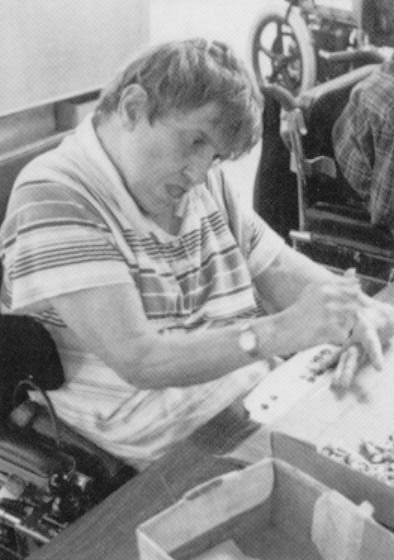
Her fear is not exaggerated. Consider the case of Jackie, a high school graduate, with mild retardation, who reads, writes, can cook and take buses around Milwaukee. When her mother died nine years ago she was thrown into a grim and crowded nursing home solely for people with developmental disabilities. She is not allowed to leave the facility because the surrounding neighborhood is considered unsafe. Fearful of retaliation from staff, she asks that her last name not be printed. Her sister, who is fighting for her release, says her sister is losing the skills that once let her live at home. Jackie has been on and off a waiting list for a group home for 10 years. “I want my privacy,” she whispers in the noisy cafeteria at the home. “I want my freedom. I want to get out of here.”
To get people like Jackie out of nursing homes may require more money, or at least a redistribution of existing funds. Most federal funding is directed to institutions and nursing homes and that discourages states from setting up community programs, complains Dennis Harkins of Wisconsin’s developmental disabilities office. In Wisconsin, two-thirds of such money serves 5,500 residents of nursing homes and institutions, while a third pays for 25,000 people in community programs, he says. Proposed legislation by Senator John Chafee (R-RI.) would freeze funding at current levels to institutions with more than 15 beds, in effect forcing states to spend more on smaller homes. But after seven years, Chafee’s bill is perhaps irreversibly stalled in Congress. Forceful opposition has come from unions, which fear job losses at institutions, and vocal parents with children in state facilities who distrust states’ ability to provide safe community-based programs.
Recent federal nursing home reforms laws, however, are aimed at ending “warehousing” of residents. Facilities are required to focus on rehabilitation, a tenet of the disability field that is now being applied to better the lives of both disabled and elderly residents of nursing homes. Jayn Wittenmyer of the Wisconsin Council on Developmental Disability, a state advisory group, says the changes are double-edged. The reforms assured that Medicaid would subsidize institutional care of younger people, she says, making it “more lucrative” for homes to set aside beds for young disabled residents. That may make it harder to get them out of nursing homes in the long run. But for now, the reforms will bring improvement at some homes for young people, like the Marian Franciscan Home in Milwaukee.
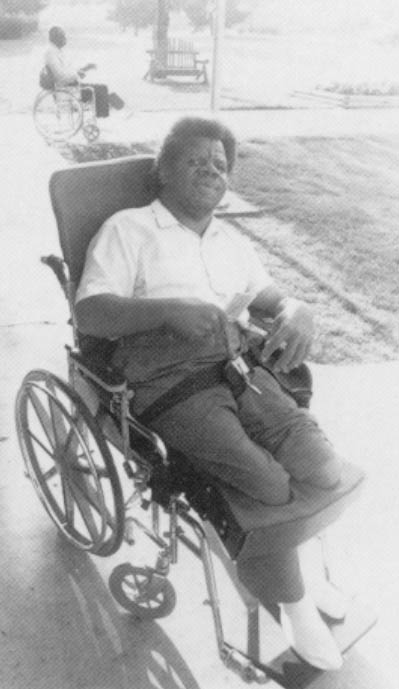
Four years ago, the Wheaton Franciscan System, a private Catholic health care concern, took over the 400-bed nursing home with a separate wing for 107 disabled people. The nursing home staff is helping Erickson and 30 others appeal for proper wheelchairs. The previous owner of the home actively discouraged residents from having electric wheelchairs, since that gave them freedom of movement and made it harder for the staff to control them. But, prodded by federal and state audits, the nursing home has begun getting younger residents out of the home and into work programs. Forty now leave to work in enclaves with other residents to make garbage bags and sheets of fabric softener that are sold at the home.
Even with these changes, officials at Marian Franciscan agree a nursing home is no place for a young person. “How many of us live with 107 other people?” asks Cynthia Sook, a home official. “We try to make it comfortable for young people, but it’s still an institution.”
©1991 Joseph P. Shapiro
Joseph P. Shapiro, an associate editor of U.S. News & World Report, is examining the disability rights movement.


